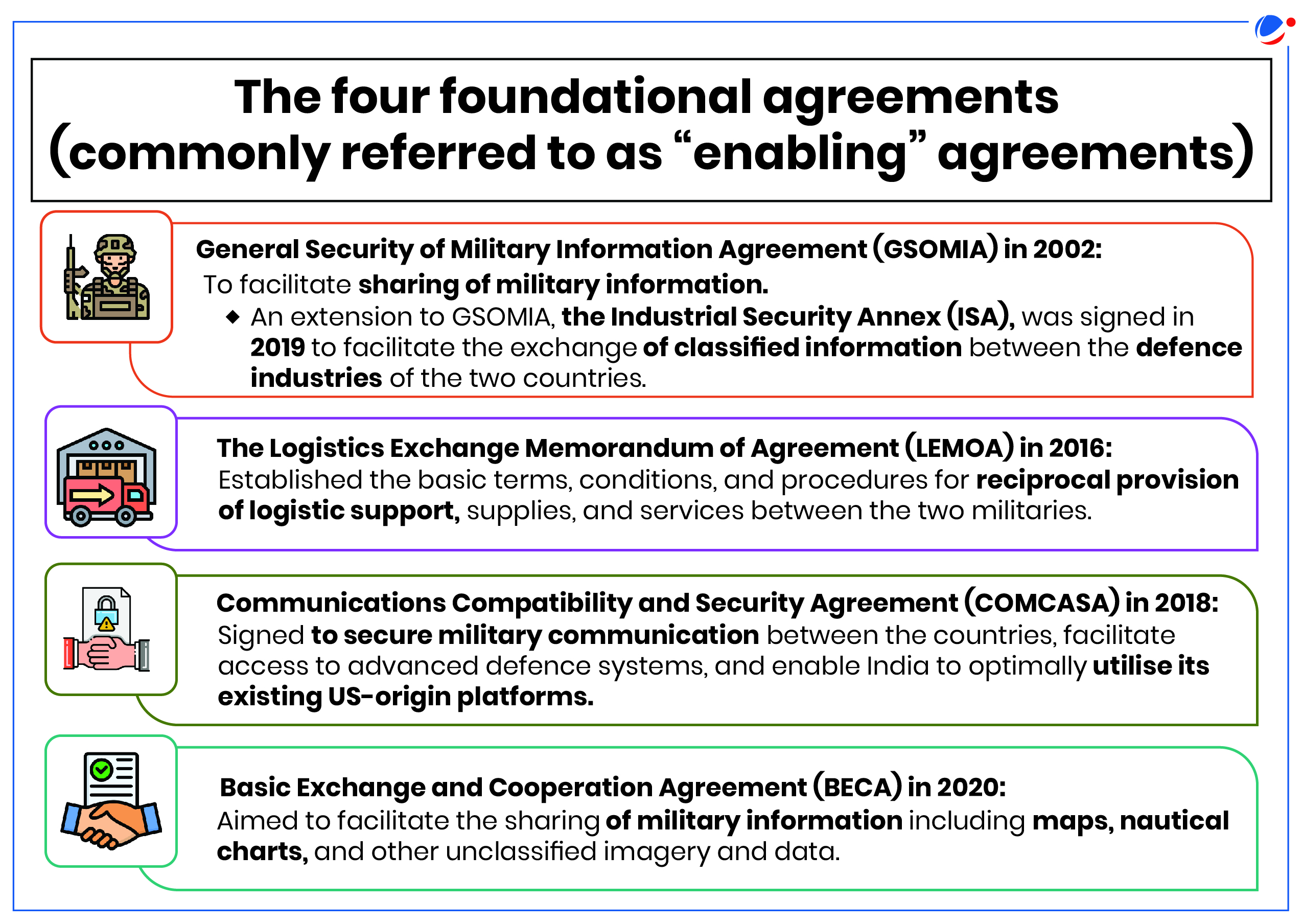Why in the News?
India and the US have signed a Security of Supply Arrangement (SOSA) and Memorandum of Agreement (MoU) regarding the Assignment of Liaison Officers, during the Defence Minister's visit to the US.
More on the news
- Security of Supply Arrangement (SOSA)
- Promote national defence: Governments to secure the mutual timely provision of defence-related goods and services during peacetime, emergency, and armed conflict.
- Meet national security needs: It would allow both countries to request each other for priority delivery of certain defence items.
- India is the 18th SOSA partner of the US. It is legally non-binding.
- The US and India are negotiating a binding Reciprocal Defence Procurement (RDP) Agreement.
- MOU on Assignment of Liaison Officers: Increase information-sharing between India and the US, and post-Indian armed forces officers in key strategic US Commands
- India will deploy the first Liaison Officer to the US Special Operations Command headquarters in Florida.
India-US cooperation milestones on defence
- The Framework for the US-India Defence Relationship (2015): Formalized both countries' commitment to enhancing cooperation in the defence sector.
- The US designated India as a Major Defence Partner in 2016: This led to India's 2018 elevation to Strategic Trade Authorization tier 1 status, granting license-free access to various military and dual-use technologies.
- The 2+2 meetings between India-US (2018): The 2+2 meetings signify the participation of Ministers holding Foreign and Defence portfolios, from each of the two countries.
- Aim: To build a stronger, more integrated strategic relationship in a rapidly changing global environment.
- The roadmap for defence industrial cooperation (2023): Priority areas of cooperation included Intelligence, Surveillance, and Reconnaissance (ISR), Undersea Domain Awareness, Air Combat and Support, etc.
- The US-India Initiative on Critical and Emerging Technology (iCET) (2023): To expand the strategic technology partnership and defence industrial cooperation.
- INDUS-X: Took forward the commitment to build a defence innovation bridge under iCET.
- India and the US have signed four foundational agreements: For enhanced military cooperation (See infographic).

Significance of India-US defence cooperation
- Diversifying India's Defence Suppliers: Russia supplied 65% of India's weapons purchases of more than $60 billion during the last two decades, according to the Stockholm International Peace Research Institute (SIPRI).
- E.G., SOSA allows India to diversify defence suppliers, reducing dependence on Russian equipment.
- Intensifies the Indo-US strategic partnership: The four 'foundational agreements' bring India closer to the US; give India access to advanced US intelligence information, etc.
- Deepen military partnership and interoperability: E.g., The Malabar exercises (India hosted Australia, Japan and U.S. forces in 2024) have provided a shared platform for exchanging doctrines, refining training skills, etc.
- Counter China in the Indo-Pacific: India's increasing role in shaping regional security by ensuring freedom of navigation, now especially as a member of the Combined Maritime Force (CMF).
- CMF is a multi-national naval partnership to promote security, stability, and prosperity across approximately 3.2 million square miles of international waters.
- Access to advanced US defence technology: E.g., India became the first non-treaty partner to be offered a MTCR Category-1 Unmanned Aerial System-the Sea Guardian UAS.
- Industrial growth: The growing synergies in defence ecosystems under the INDUS-X can help to diversify investment opportunities, high-potential start-ups, exposure to emerging defence markets, etc.
Challenges in India-US Defence cooperations
- Strategic Divergences: India's ties with Russia (arms & oil purchases), and US relations with Pakistan create friction in the defence partnership.
- Treat of US's Countering American Adversaries Through Sanctions Act (CAATSA) for procuring military hardware from Russia.
- Lack of technology transfer: The US companies prefer arms sales over technology sharing.
- Regulatory Hurdles: India's slow acquisition process and offset credit issues deter US firms.
- Indo-US defence partnership escalates tensions: The closer Indo-US strategic partnership raises a regional security issue, as China sees it as a threat.
- Intellectual property concerns: US has included India in the 'priority watch list' of countries for alleged problems related to IP protection and enforcement, and has said there will be particularly intense bilateral engagement on the matter during the coming year.
Way forward
- Focus on interoperability: Increase joint military exercises and training programs to improve interoperability between US and Indian forces.
- Expand intelligence sharing: Deepen intelligence cooperation, particularly in areas of mutual concern such as counter-terrorism and regional security threats.
- Conclude the Reciprocal Defence Procurement (RDP) Agreement: It promotes rationalisation, standardisation, interchangeability, and interoperability of conventional defence equipment with US allies and other friendly governments
- Conclude pending negotiations: E.g., Negotiations are underway to manufacture GE F-414 jet engines in India for the LCA MK 2 fighters.
- Advance Multilateral Coordination: Prioritise coordination in forums like the Quad and I2U2 (India, Israel, the US, and the UAE) to address international strategic issues.
Conclusion
India-US defence agreements mark a significant step forward, enhancing strategic ties, fostering technology sharing, and bolstering regional security through deeper cooperation and mutual commitment to shared goals.





